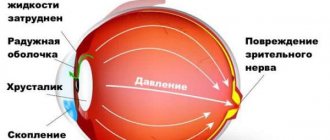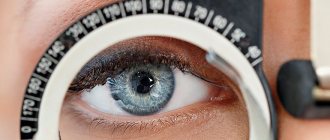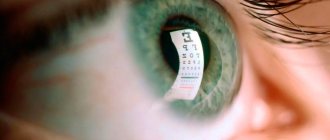Blindness is a pathological condition characterized by a sharp decrease or complete absence of visual functions. The diagnosis of blindness is made when the visual ability is less than 0.05 diopters (3/60) or the visual field is narrowed to 10 degrees. According to the World Health Organization, there are about 100 million blind people in the world, most of whom (90%) live in developing countries. Thanks to the development of medicine, in approximately 75% of cases, blind patients manage to partially or completely restore visual functions.
Causes
The list of factors leading to a sharp decrease in visual acuity is quite large. The most common causes of blindness are:
- cataract – partial or complete clouding of the lens of the eye;
- glaucoma is a chronic disease characterized by increased intraocular pressure;
- keratitis – inflammation of the cornea of the eye, leading to its clouding;
- diabetic retinopathy is a severe complication of diabetes mellitus, manifested by damage to the vessels of the retina of the eyeball;
- trachoma is a chronic eye infection caused by chlamydia, affecting the conjunctiva and cornea;
- onchocerciasis is a parasitic disease accompanied by damage to the skin and eyes;
- arterial hypertension – high blood pressure;
- intrauterine pathologies of the fetus - damage to the organs of vision during embryonic development can occur as a result of infectious diseases of the mother: rubella, toxoplasmosis, influenza, tuberculosis;
- damage to the occipital lobe of the brain due to injury or infectious diseases;
- eyeball injuries.
Various diseases of the central nervous system can lead to blindness - meningitis and encephalitis (inflammation of the substance and membranes of the brain), toxic damage to the brain. In elderly people, a sharp decrease in vision is often associated with degenerative changes in the retina and optic nerve.
WHO activities
WHO's work is guided by the recommendations contained in the World Vision Report (2019) and the resolution adopted by the 73rd World Assembly on “Integrated people-centred eye care, including combating preventable blindness and preventable visual impairment.” health in 2021. The main message of the report and resolution is the need to consider integrated and people-centred eye care as the preferred model for eye health and ensure its widespread implementation in countries. By shaping the global eye health agenda, the report and resolution are expected to contribute to the efforts of Member States and their partners to reduce the burden of eye diseases and visual impairments and achieve the Sustainable Development Goals (SDGs), in particular SDG target 3.8 on universal health coverage.
Some of WHO's main areas of work and activities in the area of blindness prevention include:
- collaborating with Member States and other local partners to recommend actionable global targets for integrated, people-centred eye care by 2030;
- holding and promoting World Sight Day as an annual outreach event;
- Ongoing work to prepare guidance documents to support the implementation of the recommendations contained in the World Vision Report:
- a practical guide to providing comprehensive, people-centred eye care;
- a package of evidence-based interventions in the field of eye care and recommendations for their integration into the health care system;
- a myopia toolkit for using mobile devices to promote health literacy and awareness of modifiable risk factors, the potentially permanent consequences of myopia, and the importance of wearing glasses as prescribed and getting regular eye exams;
- guidelines for assessing eye care services;
- guidelines for evaluating diabetes and diabetic retinopathy services;
- guidelines for evaluating glaucoma care services;
- guidelines for evaluating refractive error services;
- A guide to evaluating rehabilitation services and systems.
Classification
The classification of blindness is based on the causes, clinical manifestations of the disease, and the degree of decrease in visual acuity. A detailed classification with explanations is presented in the table.
| Classification sign | Form of pathology | Comments |
| Cause of pathology | congenital | caused by genetic disorders and the influence of teratogenic factors on the fetus (physical, chemical, biological effects leading to intrauterine pathologies) |
| acquired | develops as a result of diseases or injuries at any age | |
| Clinical manifestations | amaurosis | damage to the retina or optic nerve in the absence of visible damage |
| scotoma | the appearance of dark spots before the eyes that partially cover the image in question | |
| hemianopsia | a disease manifested by loss of individual visual fields, develops as a result of damage to brain structures | |
| color blindness (color blindness) | pathology manifested by abnormal color perception | |
| hemeralopia (night blindness) | twilight vision impairment, a condition in which a person loses the ability to distinguish objects in the dark | |
| Degree of decrease in visual acuity | absolute (full) | visual acuity is zero |
| subject | there is no ability to distinguish objects, but the perception of light and changes in its intensity are preserved | |
| civil (partial, incomplete, practical) | the patient is unable to count the fingers on his hand at a distance of three meters, there is a limitation in the ability to move and self-care | |
| professional | a condition of visual functions in which the patient cannot perform his professional duties |
Braille system
Louis Braille attended the Hayu school in 1819 and later taught there. He soon decided to create a reading and writing system that could bridge the critical communication gap between the sighted and the blind. In his own words: “Access to communication in the broadest sense is access to knowledge, and this is vital to us if we [the blind] are not to continue to despise or patronize sighted people. We don't need pity and we don't need to be reminded that we are vulnerable. We need to be treated as equals—and communication is how this can be accomplished."[7]
Table of alphabets for English Braille. The letter "W" is not part of the French alphabet, but was only added to additional letters with diacritics.
In 1821, Braille learned of a communications system developed by Captain Charles Barbier of the French Army.[8][9][10] Barbier's "night letter" was a code of dots and dashes printed on thick paper. These impressions could be interpreted solely with their fingers, allowing soldiers to exchange information on the battlefield without light or the need to speak.[11]
The captain's code proved too complex to use in his original military uniform, but it inspired Braille to develop his own system.[12][13] Braille worked tirelessly on his ideas, and his system was largely completed by 1824, when he was only fifteen years old.[7][14] Beginning with Barbier's night letter, he innovated by simplifying its form and maximizing its effectiveness. He made equal columns for each letter and reduced the number of raised dots to six. He published his system in 1829, and by the second edition in 1837, the dashes were dropped because they were difficult to read. Importantly, smaller Braille cells could be recognized as letters with the touch of a finger.[14]
Symptoms
According to clinical manifestations, there are several forms of blindness, which differ in a certain set of symptoms.
- Amaurosis is complete blindness in one or both eyes while maintaining the pupillary reaction to light, developing mainly due to damage to the central nervous system. Vision loss is often preceded by acute cerebral circulatory disorders. Amaurosis, as a rule, is combined with other eye pathologies: keratoconus (dystrophic changes in the cornea), cataracts (clouding of the lens), astigmatism (impaired visual functions associated with an irregular shape of the lens or cornea), strabismus (strabismus). Patients with this form of blindness are rarely able to distinguish light from dark or track the movement of nearby objects.
- Scotoma is a defect in the visual fields in the form of dark spots before the eyes that partially cover the object in question. The pathology develops against the background of damage to nerve fibers or blockage of retinal vessels, chronic neurological diseases, for example, multiple sclerosis, and increased intracranial pressure.
- Hemianopsia is bilateral blindness with damage to one half of the visual fields. In the homonymous form of hemianopsia, both right or left halves are lost; in the binasal form, the nasal halves are lost; in the bitemporal form, the temporal parts of the visual field are lost. Hemianopsia occurs with damage to the optic nerves and parts of the brain, benign and malignant neoplasms, inflammatory processes, and cerebrovascular accidents.
- Color blindness (color blindness) is a hereditary pathology that involves impaired ability to distinguish certain colors. There are several forms of color blindness. With protanopia, the perception of red color disappears, with deuteranopia - green, with tritanopia - the blue-violet spectrum, with achromatopsia only black and white vision is preserved.
- Hemeralopia (night blindness) is a disease in which a person loses the ability to clearly distinguish objects in the dark. Patients with hemeralopia complain of a sharp decrease in acuity, narrowing of visual fields, impaired color perception, especially in the yellow and blue spectrum, when it gets dark. During the day, visual acuity and color perception remain normal.
Note! In most cases, vision deterioration occurs gradually, and complete blindness can be prevented if you consult a doctor in time and begin treatment.
Diagnostics
Instrumental and hardware research methods help to establish the degree of vision loss and identify the cause of the disease:
- visometry - testing visual acuity, in combination with other methods allows you to diagnose the degree of visual impairment;
- perimetry - determination of visual fields, consists of establishing the upper, lower and lateral visible boundaries, as well as identifying visual defects (losses) within these boundaries;
- ophthalmoscopy - examination of the fundus and optical media of the eye, helps to identify developmental anomalies, dystrophic changes in the retina and choroid, pathologies of the vitreous body, optic nerve head;
- fluorescein angiography - examination of the retina using a special camera, allows you to detect abnormal phenomena in the blood vessels, defects in the structures of the visual apparatus, the appearance of new vessels, the initial stage of retinal detachment;
- electroretinography is a study of the retina by recording electrical potentials that are formed in response to light stimulation; it is used for examination of thinning and degeneration of the retina, cataracts, occlusion (closing of the lumen) of the veins and arteries of the retina.
Note! The list of necessary examinations is selected individually after the initial ophthalmological examination, depending on the disease that led to the suppression of visual functions.
Aniruddha Bank for the Blind
An estimated 253 million people live with visual impairment: 36 million blind and 217 million have moderate to severe visual impairment worldwide, with nearly 80 lakh in India itself, of which the number of blind students is close to 30 lakh. According to the law of nature, when one sense organ is not functioning in the human body, other sense organs become more active to compensate for the defect. In the case of blind people, hearing and touch are very active and play an important role. Aniruddha Bank for the Blind, conceptualized and operationalized by Shri Aniruddha Upasana Foundation, Mumbai, India, supports education for the blind in a gentle and unique way. The bank has recorded curriculum in 12 languages like English, Hindi, Marathi, Gujarati, Tamil, Kannada, Bengali, Malayalam, Telugu, Sanskrit, etc. from people who have good knowledge of their mother tongue. To date, recorded CDs have changed the lives of blind people in nearly 26 states of India, as well as several regions of neighboring Pakistan. The Bank maintains the high quality and standard of CDs through regular and thorough inspection.[16][17][18]
Treatment
Treatment tactics for complete or partial blindness depend on the form of pathology, the age of the patient and concomitant diseases. So, with transient amaurosis, to restore blood circulation, patients are urgently prescribed vasodilators, anticoagulants and thrombolytic agents.
For scotomas, treatment is determined by the cause of the disease. If the defects arise as a result of retinal detachment, surgical intervention is indicated - vitrectomy (removal of the vitreous body followed by filling the eye cavity with silicone gel or gas). If visual disturbances occur due to pathological neoplasms, they are removed. For blindness caused by cerebral vascular spasm, antispasmodics are prescribed.
Treatment of hemianopsia is based on identifying and eliminating the cause of the disease. Neurosurgical intervention is performed for traumatic brain injuries, benign or malignant brain tumors. Specific treatment for color blindness and hemeralopia has not been developed. To correct visual functions, glasses with special filters or contact lenses are used.
Recommendations
- ^ a b "Middle Egyptian: An Introduction to the Language and Culture of Hieroglyphs"
, James P. Allen, p. 343, Cambridge University Press, 2000, ISBN 0-521-77483-7 - ^ a b
"
History of Special Education
", Margret A. Winzer, p. 463, Gallaudet University Press, 1993, ISBN 1-56368-018-1 - " Everybody Belongs
", Arthur H. Shapiro, page 152, Routledge, 2000, ISBN 0-8153-3960-7 - National Cyclopaedia of Useful Knowledge, Volume III,
(1847), London, Charles Knight, p. 426. - "Into the Royal School for the Blind Archives - A History of the Place." historyof.place
. Retrieved 2019-08-01. - Herbermann 1913. sfn error: no target: CITEREFHerbermann1913 (help)
- ^ a b
Olmstrom, pp. 161–162. - Kugelmass (1951), pp. 108–115.
- Marsan, Colette (2009). "Louis Braille: A Brief Overview". Association Valentin Haüy. Retrieved November 7, 2011.
- "Who was Louis Braille?" Royal National Institute of Blind People (RNIB). 2010. Retrieved November 7, 2011.
- Farrell, page 96.
- Kugelmass (1951), pp. 117–118.
- Farrell, pp. 96–97.
- ^ a b
Farrell, p. 98. - The Blind: Their Condition and the Work Done for Them in the United States
, Harry Best, p. 372, Macmillan Company, 1919. - https://www.who.int/mediacentre/factsheets/fs282/en/
- "Archival copy." Archived from the original on 2019-04-23. Retrieved 2018-04-11.CS1 maint: zipped copy as title (link)
- https://aniruddhafoundation.com/compassion-aniruddhas-bank-for-the-blind/
Prevention
There is no specific prevention of blindness. Preventive measures are general in nature and consist of timely treatment of infectious and inflammatory diseases, strict adherence to safety rules during production work associated with a high risk of eye injury, as well as compliance with visual hygiene standards.
To prevent the development of blindness, patients at risk should be examined regularly (at least once a year) by an ophthalmologist, and also receive timely and adequate treatment.
Today
Waikiki-Kapahulu Library for the Blind and Handicapped in Honolulu, Hawaii
Most blind and visually impaired students now go to nearby schools.[ where?
], are often assisted in their educational endeavors by full-time academic teachers and a team of professionals who teach them alternative skills: Orientation and Mobility (O and M) training - independent travel training - usually provided by contractors trained in the field, as is font Braille. Blind children may also require special training to understand spatial concepts and self-care, since they often cannot learn visually and through imitation the way other children do.
Since only ten percent of those registered as legally blind are blind, many students are also taught to make the most of their remaining vision, so that some read print (with or without optical aids) and travel without a cane.
The combination of essential teaching tailored to each student's unique needs and solid academics goes a long way toward preparing students who are blind and visually impaired to cope with the world independently.









